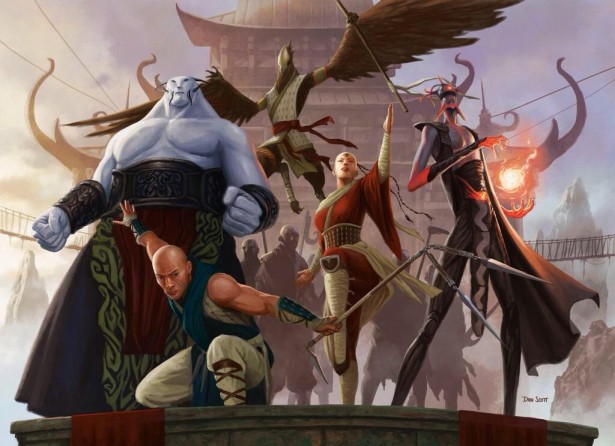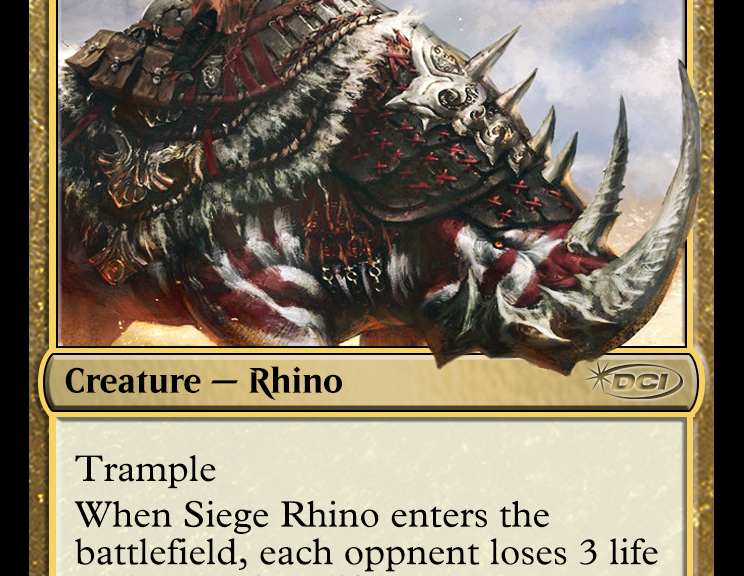Finals: Lax vs. Mclaren
Ari Lax defeats Shaun McClaren to establish Abzan mid-range as the deck to beat this fall. Look for Sorin and Siege Rhino to rise. Huge congratulations to Ari Lax on his 1st Pro Tour win and to fellow Canadian Shaun McClaren on his fantastic 2nd place finish, less than a year after his own win.
The story of the day continues: Jeskai vs Abzan
Semi-Finals 2: Sigrist vs. Mclaren
- McClaren puts Sigrist away easily, reinforcing the potential for Mantis Rider and Dig Through Time to be mainstays alongside Rabblemaster this fall
- Dig Through Time called out again as card of the tourney and a key success factor for Shaun
- Lax just top decked Elspeth for the win, perhaps ensuring she’ll maintain some upward price momentum
- Lax vs Thiago see split 1-1
- Abzan Aggro gets another chance to demonstrate dominance over the Jeskai builds to see who makes the finals
Semi-Finals 1: Ari Lax vs. Thiago
- Abzan mid-range mirror match
Quarter-Final 4: Lee Shi Tian (Jeskai Combo) vs. Shaun McClaren (Jeskai Wins)
- McClaren keeps Shi Tian on the back foot the whole game to take Game 2, and win into the semi-finals
- Lee Shi Tian has access to a full 15 card transformative sideboard, turning into a mid-range Temur deck using 4 Savage Knuckleblade, but only does a partial switch for Game 2
- Shaun takes Game 1 from Jeskai Combo, using Mantis Rider to ensure a weak hand from Shi Tian doesn’t get it done
- Coverage team breaking down how the Jeskai combo works, highlighting Jeskai Ascendancy as the key card
- Go Canada go! (totally unbiased)
- This match gives us an interesting new head-to-head of two different Jeskai builds
Quarter-Final 3: Mike Sigrist (Abzan Aggro) vs. Ivan Flock (UB Control)
- Sigrist takes a convincing game 2 to put the Abzan decks at 3-0 in the quarter-finals!
- Ajani, Mentor of Heroes on camera punishing Floch
- Sigrist takes Game 1 and makes clear that Abzan has game in multiple configurations
- Prognostic Sphinx being shown to match up poorly against the meta-gamed choice to run Raskshasa Deathdealer and Fleecemane Lion on the aggro plan
- This round will give Abzan a high profile shot at proving it’s ability to handle control decks
Quarter-Final 2: Thiago Saporito (Abzan Mid-Range) vs. Ondrej Strasky (Jeskai Wins)
- Abzan takes down Jeskai Wins again to take the top table record to 2-0 in the war of clans
- Thiago goes up a game, but is quoted on saying that Strasky is favored after sideboarding
- LSV calling out Dig Through Time as a key missing card for Strasky
- Strasky build of Jeskai Wins contains a few cards of note as well, including: 3 copies of Ashcloud Phoenix and the oft-overlooked 4 Hushwing Gryff. Gryff is a meta-call against comes into play abilities like the ones found on Siege Rhino and Wingmate Roc. Gryff was easily available for $1.25 heading into the weekend, but has been inching up towards $2+ since first being mentioned on camera tomorrow.
- We get to see another Abzan vs. Jeskai tempo/burn match here, which could help establish the pecking order for the format
- Willy Edel being credited for designing the deck
- LSV is highlighting the use of 2 copies of Anafenza in Thiago’s deck (1 main/1 sideboard)
- Of note in the Thiago Abzan build is the presence of 4 Wingmate Roc, 2 Sorin, and 4 Siege Rhino
Quarter-Final 1: Ari Lax (Abzan Mid-Range) Vs. Yuyaa Wantanabe (Jeskai Wins)
- Ari takes Game 2 to defeat Jeskai Wins and but Abzan one step closer to taking the tournament and increasing the profile of Siege Rhino, Sorin, Solemn Visitor, Wingmate Roc and Utter End as potential #mtgfinance gainers
- In Game 2 Ari is making planewalkers, including Sorin, look great in this format
- Ari takes down Yuyaa in Game 1, demonstrating that even Abzan mid-range can handle a shaky draw from the Jeskai deck with the right tools in hand
After 16 exciting rounds the table is now set for one of the most dynamic and diverse Pro Tour Top 8’s in recent memory.
Here’s where we’re at in terms of players and decks:
- Shaun McClaren (Jeskai Burn)
- Ivan Floch (U/B Control)
- Ari Lax (Abzan Mid-Range)
- Mike Sigrist (Abzan Aggro)
- Ondrej Strasky (Jeskai Wins)
- Yuyaa Wantanabe (Jeskai Wins)
- Thiago Saporito (Abzan Midrange)
- Yuyaa Wantanabe (Jeskai Wins)
That’s a dominant 3 versions of Jeskai builds centered on tempo and burn, along with 1 Jeskai Ascendancy combo deck, 3 versions of Abzan builds and a lone U/B control build in the competent hands of master control player Ivan Floch.
Notably absent from Top 8 after solid showings this weekend are the Green Devotion decks in their various forms, the various graveyard based Whip/Sidisi/Hornet builds, and a variety of Esper and Jeskai flavored control decks.
In terms of card copies, here are the key #mtgfinance cards that dominate these Top 8 lists ranked by total copies in main and board:
- Hero’s Downfall (15)
- Thoughtseize (15)
- Siege Rhino (12)
- Sylvan Caryatid (12)
- Dig Through Time (11)
- Prognostic Sphinx (9)
- Mantis Rider (8)
- Wingmate Roc (8)
- Goblin Rabblemaster (8)
- Fleecemane Lion (8)
- Sorin, Solemn Visitor (7)
- Elspeth, Sun’s Champion (6)
- Mana Confluence (6)
- Anger of the Gods (6)
- Sarkhan, Dragonspeaker (5)
- Silence the Believers (4)
- Savage Knuckleblade (4)
- Rakshasa Deathdealer (4)
- Clever Impersonator (3)
- Brimaz, King of Oreskos (3)
- Ajani, Mentor of Heroes (2)
- Stormbreath Dragon (2)
- Nissa Worldwaker (2)
- Polukranos (2)
- Hushwing Gryff (4)
- Jeskai Ascendancy (4)
- Pearl Lake Ancient (1)
For the cards on this list that were undervalued, look for them to rise. For those that were already high, their status should be safe for now.



